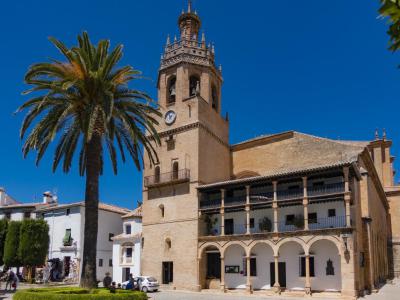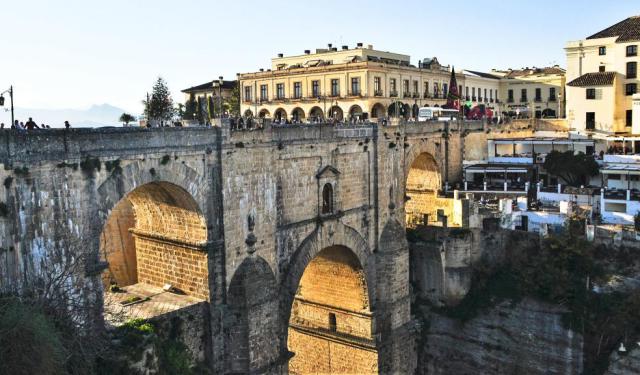
Iglesia de Santa Maria la Mayor (Church of Saint Mary the Elder), Ronda
Built on the remains of a 13-century mosque, the Church of Saint Mary the Elder is located in the Town Hall Square of Ronda. The Square is also known as the Duchess of Parcent Square (Plaza Duquesa de Parcent) in memory of one of the first women who occupied a seat in the Spanish Congress.
The Church of Saint Mary's odd tower and facade make it look more like a City Hall. The main entrance opens to a small vestibule chamber. It contains one of the original columns of the cathedral built just after 1485. An earthquake in 1580 destroyed the original structure. The current building is a replacement.
The Medina Mosque, replaced by the original church, was itself constructed on top of a Visigothic church built on top of a Roman altar of the goddess Diana honoring Julius Caesar's victory over Pompey.
The balconies on the facade were added in the late 16th century, during the reign of Philip II. The balconies were for noble spectators of tournaments put on by the School of Cavalry (Maestranza de Caballería), a military training fraternity of nobles.
The Church of Saint Mary the Elder still holds the Mirhab prayer niche of the Medina Mosque. There is also a wall with Ataurique decorations behind the altar. The original church was Gothic. Its replacement is Renaissance. Gothic elements remain in the columns and the ogives.
There is a two-level choir of cedar and walnut. Seatbacks are adorned with carvings of symbols of Mary and the Sacred Heart, apostles, and saints. The Baroque altarpiece of the Virgin of Great Sorrow is attributed to sculptor Guido Montanes Castillo.
The Church of Saint Mary's odd tower and facade make it look more like a City Hall. The main entrance opens to a small vestibule chamber. It contains one of the original columns of the cathedral built just after 1485. An earthquake in 1580 destroyed the original structure. The current building is a replacement.
The Medina Mosque, replaced by the original church, was itself constructed on top of a Visigothic church built on top of a Roman altar of the goddess Diana honoring Julius Caesar's victory over Pompey.
The balconies on the facade were added in the late 16th century, during the reign of Philip II. The balconies were for noble spectators of tournaments put on by the School of Cavalry (Maestranza de Caballería), a military training fraternity of nobles.
The Church of Saint Mary the Elder still holds the Mirhab prayer niche of the Medina Mosque. There is also a wall with Ataurique decorations behind the altar. The original church was Gothic. Its replacement is Renaissance. Gothic elements remain in the columns and the ogives.
There is a two-level choir of cedar and walnut. Seatbacks are adorned with carvings of symbols of Mary and the Sacred Heart, apostles, and saints. The Baroque altarpiece of the Virgin of Great Sorrow is attributed to sculptor Guido Montanes Castillo.
Want to visit this sight? Check out these Self-Guided Walking Tours in Ronda. Alternatively, you can download the mobile app "GPSmyCity: Walks in 1K+ Cities" from Apple App Store or Google Play Store. The app turns your mobile device to a personal tour guide and it works offline, so no data plan is needed when traveling abroad.
Iglesia de Santa Maria la Mayor (Church of Saint Mary the Elder) on Map
Sight Name: Iglesia de Santa Maria la Mayor (Church of Saint Mary the Elder)
Sight Location: Ronda, Spain (See walking tours in Ronda)
Sight Type: Religious
Guide(s) Containing This Sight:
Sight Location: Ronda, Spain (See walking tours in Ronda)
Sight Type: Religious
Guide(s) Containing This Sight:
Walking Tours in Ronda, Spain
Create Your Own Walk in Ronda
Creating your own self-guided walk in Ronda is easy and fun. Choose the city attractions that you want to see and a walk route map will be created just for you. You can even set your hotel as the start point of the walk.
Ronda Introduction Walking Tour
Ancient rock paintings found in the area tell us Ronda was settled by Celts, who called it "Arunda." Phoenicians and Romans followed the Celts. Muslim rule was established in 713 by the Umayyads, who called it the "Castle of Rundah." Islamic domination ended in 1485 when Rodrigo, Duke of Cadiz, conquered the city.
Seen from the air, Ronda is breathtaking. It is in two parts,... view more
Tour Duration: 2 Hour(s)
Travel Distance: 2.8 Km or 1.7 Miles
Seen from the air, Ronda is breathtaking. It is in two parts,... view more
Tour Duration: 2 Hour(s)
Travel Distance: 2.8 Km or 1.7 Miles

